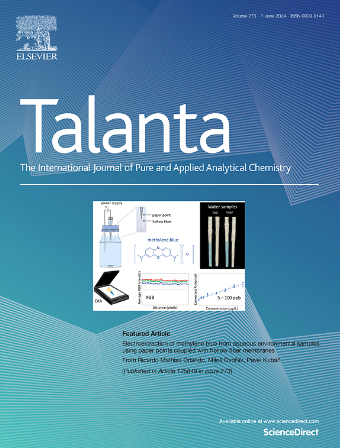Natural deep eutectic solvent-based hollow polymer inclusion membrane doped with TiO2 nanoparticles: A new design of polymer inclusion membrane for on-chip electromembrane extraction of fluoroquinolones from food samples prior to liquid chromatography tandem mass analysis
IF 5.6
1区 化学
Q1 CHEMISTRY, ANALYTICAL
引用次数: 0
Abstract
A new design of polymer inclusion membrane has been proposed with the aim of addressing issues with using common forms of liquid membranes. To do so, a natural deep eutectic solvent (NADES) was employed as an extractant in the structure of the hollow polymer inclusion membrane (HPIM). Besides polyvinyl chloride (PVC) as a base polymer, titanium dioxide nanoparticles (TiO2) as well as polyethylene glycol polymer (PEG) were incorporated into the HPIM structure to achieve a nanocomposite form with a desirable hydrophilicity. The optimal HPIM was composed of 12.5 v/w% of thymol-coumarin NADES, 3.0 w/w% of TiO2 and 40.0 v/w% of PEG based on PVC content. Aiming to compare the applicability, HPIMs with other types of extractants, such as bis(2-ethylhexyl) phthalate (DEHP), and the mixture of DEHP-NADES were also fabricated. To confirm the successful fabrication of the HPIM, containing the aforementioned extractant doped with TiO2 nanoparticles various characterization techniques were employed. The resultant HPIM was employed as a liquid membrane in an on-chip electromembrane extraction (EME) of fluoroquinolones (FQs) from various samples, followed by LC-MS/MS analysis. The parameters influencing extraction performance were analyzed, and the proposed method was validated under ideal conditions. All the samples provided excellent performance concerning limits of detection (0.01–0.08 ng mL−1), and quantification (0.03–0.25 ng mL−1) together with an excellent linearity (R2 ≥ 0.9978). The method indicates the desirable RSDs% in the range of 3.2–7.0 % (intra-day, n = 3 × 3) and 3.8–6.1 % (inter-day, n = 3 × 3) for three spiked levels. The satisfactory relative recoveries fell within the 92.0–115.0 % range.

求助全文
约1分钟内获得全文
求助全文
来源期刊

Talanta
化学-分析化学
CiteScore
12.30
自引率
4.90%
发文量
861
审稿时长
29 days
期刊介绍:
Talanta provides a forum for the publication of original research papers, short communications, and critical reviews in all branches of pure and applied analytical chemistry. Papers are evaluated based on established guidelines, including the fundamental nature of the study, scientific novelty, substantial improvement or advantage over existing technology or methods, and demonstrated analytical applicability. Original research papers on fundamental studies, and on novel sensor and instrumentation developments, are encouraged. Novel or improved applications in areas such as clinical and biological chemistry, environmental analysis, geochemistry, materials science and engineering, and analytical platforms for omics development are welcome.
Analytical performance of methods should be determined, including interference and matrix effects, and methods should be validated by comparison with a standard method, or analysis of a certified reference material. Simple spiking recoveries may not be sufficient. The developed method should especially comprise information on selectivity, sensitivity, detection limits, accuracy, and reliability. However, applying official validation or robustness studies to a routine method or technique does not necessarily constitute novelty. Proper statistical treatment of the data should be provided. Relevant literature should be cited, including related publications by the authors, and authors should discuss how their proposed methodology compares with previously reported methods.
 求助内容:
求助内容: 应助结果提醒方式:
应助结果提醒方式:


